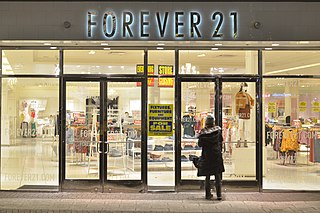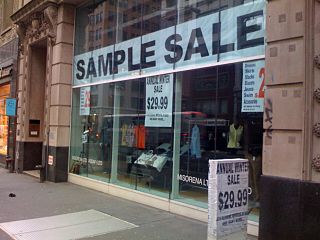This article needs additional citations for verification .(December 2009) |
A white sale is a marketing strategy in which a store steeply discounts its merchandise to increase sales during a short period of time.
This article needs additional citations for verification .(December 2009) |
A white sale is a marketing strategy in which a store steeply discounts its merchandise to increase sales during a short period of time.
In 1878, John Wanamaker of Philadelphia department store fame decreed January to be the time for a "White sale". Bed linens, which were available in white only, were sold at a discount. This was done to increase sales for these items at a time of the year when sales were normally slow. [1]
Today, white sales usually revolve around household items. However, they no longer only involve items that are white in color, and they are not restricted to take place in the month of January. "White sales" should not be confused with sales on "white goods", which is to say durable goods such as refrigerators, freezers, stoves, washing machines, and similar large appliances.

A supermarket is a self-service shop offering a wide variety of food, beverages and household products, organized into sections. This kind of store is larger and has a wider selection than earlier grocery stores, but is smaller and more limited in the range of merchandise than a hypermarket or big-box market. In everyday U.S. usage, however, "grocery store" is synonymous with supermarket, and is not used to refer to other types of stores that sell groceries.

The point of sale (POS) or point of purchase (POP) is the time and place where a retail transaction is completed. At the point of sale, the merchant calculates the amount owed by the customer, indicates that amount, may prepare an invoice for the customer, and indicates the options for the customer to make payment. It is also the point at which a customer makes a payment to the merchant in exchange for goods or after provision of a service. After receiving payment, the merchant may issue a receipt for the transaction, which is usually printed but can also be dispensed with or sent electronically.
Sales promotion is one of the elements of the promotional mix. The primary elements in the promotional mix are advertising, personal selling, direct marketing and publicity/public relations. Sales promotion uses both media and non-media marketing communications for a pre-determined, limited time to increase consumer demand, stimulate market demand or improve product availability. Examples include contests, coupons, freebies, loss leaders, point of purchase displays, premiums, prizes, product samples, and rebates.

A department store is a retail establishment offering a wide range of consumer goods in different areas of the store, each area ("department") specializing in a product category. In modern major cities, the department store made a dramatic appearance in the middle of the 19th century, and permanently reshaped shopping habits, and the definition of service and luxury. Similar developments were under way in London, in Paris and in New York (Stewart's).
Discounts and allowances are reductions to a basic price of goods or services.

Cost of goods sold (COGS) is the carrying value of goods sold during a particular period.

A variety store is a retail store that sells general merchandise, such as apparel, automotive parts, dry goods, toys, hardware, home furnishings, and a selection of groceries. It usually sells them at discounted prices, sometimes at one or several fixed price points, such as one dollar, or historically, five and ten cents. Variety stores do not include larger formats: general merchandise superstores (hypermarkets) such as Target and Walmart. Warehouse clubs like Costco, grocery stores, and department stores are also not considered variety stores.

In marketing, a coupon is a ticket or document that can be redeemed for a financial discount or rebate when purchasing a product.
Merchandising is any practice which contributes to the sale of products to a retail consumer. At a retail in-store level, merchandising refers to displaying products that are for sale in a creative way that entices customers to purchase more items or products.

John Wanamaker Department Store was one of the first department stores in the United States. Founded by John Wanamaker in Philadelphia, it was influential in the development of the retail industry including as the first store to use price tags. At its zenith in the early 20th century, Wanamaker's also had a store in New York City at Broadway and Ninth Street. Both employed extremely large staffs. By the end of the 20th century, there were 16 Wanamaker's outlets, but after years of change the chain was bought by Albert Taubman, and added to his previous purchase of Woodward & Lothrop, the Washington, D.C., department store. In 1994, Woodies, as it was known, filed for bankruptcy. The assets of Woodies were purchased by the May Company Department Stores and JCPenney. In 1995, Wanamaker's transitioned to Hecht's, one of the May Company brands. In 2006, Macy's Center City became the occupant of the former Philadelphia Wanamaker's Department Store, which is now a National Historic Landmark.

Used goods mean any item of personal property offered for sale not as new, including metals in any form except coins that are legal tender, but excluding books, magazines, and postage stamps.

Comet, trading as Comet Group, is an online electrical retail chain based in the United Kingdom. The company sold consumer electronics and white goods, along with related products and services, and pioneered the concept of the out-of-town discount warehouse in the United Kingdom.
Consignment involves selling one's personal goods through a third-party vendor such as a consignment store or online thrift store. The owner of the goods pays the third-party a portion of the sale for facilitating the sale. Consignors maintain the rights to their property until the item is sold or abandoned. Many consignment shops and online consignment platforms have a set day limit before an item expires for sale.

A closeout or clearance sale is a discount sale of inventory either by retail or wholesale. It may be that a product is not selling well, or that the retailer is closing because of relocation, a fire, over-ordering, or especially because of bankruptcy. In the latter case, it is usually known as a going-out-of-business sale or liquidation sale, and is part of the process of liquidation. A hail sale is a closeout at a car dealership after hail damage.
A catalog merchant is a form of retailing. The typical merchant sells a wide variety of household and personal products, with many emphasizing jewelry. Unlike a self-serve retail store, most of the items are not displayed; customers select the products from printed catalogs in the store and fill out an order form. The order is brought to the sales counter, where a clerk retrieves the items from the warehouse area to a payment and checkout station.

Sample sales are used by retail businesses in order to discard excess merchandise. Sometimes these samples have been used by agencies to sell products that they will distribute to local vendors. Sample sales are often associated with the fashion industry. These sales are an opportunity to get near perfect merchandise at a fraction of the price. It is often difficult to have information on the date and time of sample sales, although there are websites which list information about sample sales. They are also used to draw in new clients, hoping that the new people will return to the company's store and buy more merchandise.
The Inventory Information Approval System, or IIAS, is a point-of-sale technology used by retailers that accept FSA debit cards, which are issued for use with medical flexible spending accounts (FSAs), health reimbursement accounts (HRAs), and some health savings accounts (HSAs) in the United States.

Special journals are specialized lists of financial transaction records which accountants call journal entries. In contrast to a general journal, each special journal records transactions of a specific type, such as sales or purchases. For example, when a company purchases merchandise from a vendor, and then in turn sells the merchandise to a customer, the purchase is recorded in one journal and the sale is recorded in another.
In economics, a doorbuster or door crasher deal is an offer which is handed out early into the business's opening hours, this offer almost always is promoting a good in limited supply. These deals are designed to attract large numbers of shoppers into the business.

A price tag is a label declaring the price of an item for sale. It may be a sticker or attached by twist tie or other means.